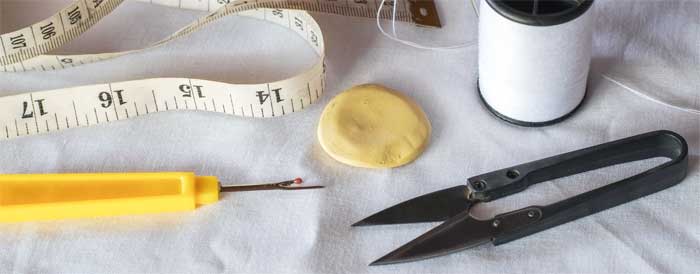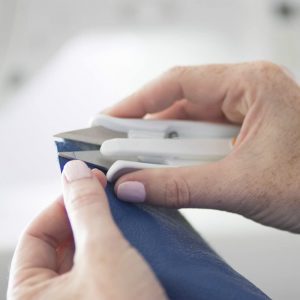In this article, we review a catch-all “Other” category of basic sewing tools that includes thread snips, seam rippers, point turners and stilettos:

Thread Snips
Thread snips, also called thread nippers, thread clippers, and thread cutters—are small, often spring-loaded, scissors used for trimming threads and are easy to keep close to your sewing machine for quick access to trim at the end of each seam. Some varieties are more heavy duty and can even be used for notching fabric.
Thread snips come in various designs, sharpness, and price points.
- Designs

Fiskars Crafts Premier Ultra-Sharp Thread Snip with blade guard (on Amazon) - Thread snips generally have a pointed tip, but you can find them with a blunt tip as well.
- Some have a metal handle and some handles are covered in rubber to make for a more non-slip handling.
- The Gingher G-TNKE and Sharp Point Quick Clip both have a special design in the handle where you grip it with your index finger which can reduce the “slip factor”.
- Fiskars offers one that includes a blade guard for added safety.
- Generally, they are about 4” long making them easy to hold in your hand
- Price Points
- As with everything, you can find nippers at various price points. Depending on your desires, you can spend as little as $12 for 12 nippers with the idea you will toss them when they dull or you can pay $28 for a single nipper with the idea you will sharpen them and use them for life.
- Sharpness
- Some are limited to thread snipping but others are touted for their ability to cut through tougher materials, like small twigs, fishing line and fabric. Choose based on what you plan to cut!
- Nippers that have been hot forged and/or made of stainless steel or double-plated chrome will have the longest life and most durable sharpness.
Seam Rippers
Seam rippers are a small tool used for removing stitches. There are two primary styles:
- The forked style tapers to a sharp point on the longer side making it easy to slip under the stitches while the other side often has a plastic ball covering the end. The sharp cutting edge is in the center of the fork. There are many options in this style. In fact, Dritz even sells one with the “extra” of a magnifying glass and LED light to help us see those little stitches. Some reviews indicate using those extras are a bit fiddly, but with practice, can be useful. Oliver + S created a 2-minute tutorial on two methods to use this style of seam ripper that you may find helpful.
- The curved blade style looks a bit like a scalpel with the sharp edge is along one side. This style often has replaceable blades, much like a rotary cutter. It can also be gentler on the fabric than other types of conventional seam rippers, as the razor-sharp curve glides through any kind of stitching. Embroidery stitching is more easily removed with these seam rippers. Just pay close attention when unstitching because these blades are very sharp.
- A third, less common version, is battery operated. An example of this style is the Galaxy Notions Electric Seam Ripper. It goes down the seam between each of the fabric layers to remove the stitches without cutting into the fabric. It is reportedly durable and sharp but does require frequent battery replacement.
No matter which style you choose, it is always important to use care not to slice your fabric as you pick out your stitches.
Point Turners
Point turners are usually made from either plastic or bamboo. They are a great tool for creating sharp corners and can also be used to crease or mark fabric temporarily. Be careful not to poke the pointed end through your fabric as you turn out your corners. Simply insert the pointed end inside the corner and pull the fabric over the end. If you have trimmed your seams well, you should have a beautiful sharp point.
Here’s a 1-minute video tutorial that will give you some quick tips on how to use your point turner. You may be surprised about some extra functions you can get out of this handy little tool!
Stilettos
Stilettos, sometimes called awls, are a great help at the sewing machine to help move fabric under the presser foot as well as several other functions. They come in a variety of styles and materials such as metal, bone, and wood. Regardless of style, they will have at least one, and sometimes two, pointed ends and a handle to hold onto. The sharp point can ride along close to your presser foot and act like a safe extra finger to help you hold fabric in place while sewing. They can be useful when picking out stitches or turning under small edges of fabric. They can also hep you to safely secure your fabric while pressing without getting too close to a dangerously hot iron.
Many stiletto options are available in sewing shops but for the non-traditionalist, you can improvise with things like a bamboo skewer (think shish-kabobs), a porcupine quill or even an ice pick.
We hope you found something new or were reminded of something old as you read through this list of sewing tools. And if you decide to try a new tool or replace an old one, don’t forget to take advantage of your member discount as you do.
See our full series of Sewing Basics/Learn to Sew articles.
~Sheryl Belson





